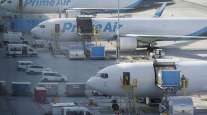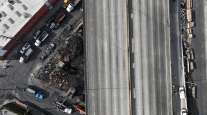Big Changes Seen in Truck, Bus Design
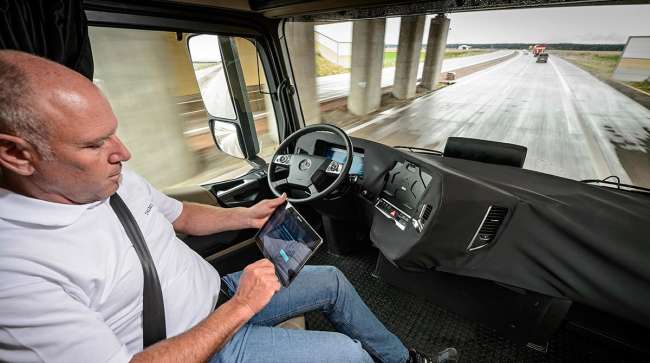
California is the “incubator” for commercial vehicle innovation that will spread throughout the nation, generating a wave of new powertrains and driver-assistance technologies designed to decrease truck emissions and increase safety and freight efficiency, a vehicle engineering consultant said.
Independent engineer Richard Mihelic, formerly with Peterbilt Motors Co., said market forces and government regulations are combining to drive changes among truck, trailer and bus makers, especially with California’s strong push for zero-emissions vehicles that includes grants and tax incentives.
MEET AEOS: Cummins unveils all-electric demonstration truck
In an Aug. 30 conference call sponsored by investment firm Stifel, Nicolaus & Co., Mihelic said truck makers will have to consider the whole freight system and not just discrete parts of it.
“We’re at the start of some revolutionary changes,” Mihelic said of truck-making today. He compared current highway vehicles with railroad locomotives around 1940 when they switched to diesel-electrics from steam engines using coal.
As an example, Mihelic cited Amazon.com and the online retailer’s practice of covering the roofs of its large warehouses with solar panels. The power generated by the panels, he said, can be used either to operate the warehouses or charge battery packs used in freight distribution.
Because there are three or four trailers for each tractor on the road, Mihelic said battery-powered trailers could be charged and ready to be hooked to tractors as part of a system for local freight distribution.
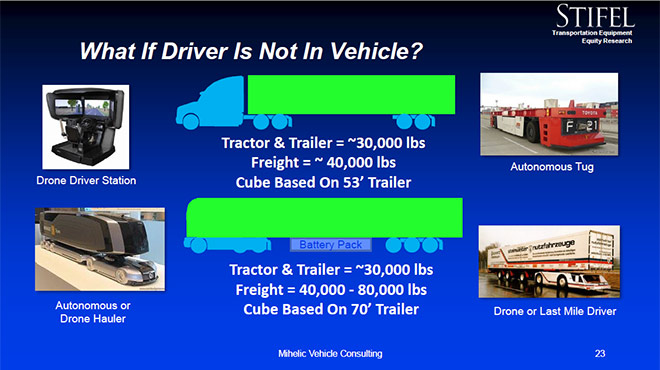
A slide showing autonomous vehicle technologies. (Mihelic Vehicle Consulting)
He told Stifel analyst Michael Baudendistel that history is filled with technologies that were thought to be guaranteed successes but then failed. Betamax video, the Titanic, Zeppelin transportation and supersonic passenger jets are examples.
But for trucks and buses now, “California has predicted for me. Consistent with their efforts on regulations, they want 100,000 zero-emissions vehicles on the roads by 2025,” Mihelic said of the Golden State’s interest in hydrogen fuel cells and batteries. “That’s a lot of opportunities for engineers to work out bugs,” he said.
The Southern California container ports of Los Angeles and Long Beach, Nos. 1 and 2, respectively, have made several highly significant policy mandates on trucks since 2000 to help improve the state’s ever-challenged air quality. The regulations address both carbon dioxide, a greenhouse gas and the criteria pollutants nitrogen oxide and particulate matter.
The two ports have banned pre-2007 trucks from picking up or delivering containers.
The port actions “make this more feasible for the rest of the marketplace,” he said.
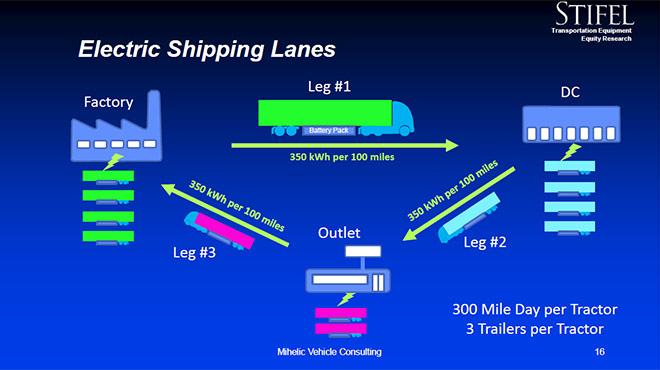
A potential distribution schedule using trailers with battery power for propulsion of their tractors. (Mihelic Vehicle Consulting)
As to which companies might end up revolutionizing trucks, Mihelic said it could be the current industry leaders or new entrants such as Nikola Motor Co. and Tesla.
Mihelic said the demonstration by Cummins Inc. of its Aeos electric tractor was noteworthy because the independent engine maker is one of the great stalwarts of diesel technology, yet now it is also working on disruptive new technologies.
A major issue for vehicle designers, Mihelic said, should be an increase in freight efficiency, measured by freight transported by a single crew. For cargo jets and ships and freight railroads, he said, much larger vessels are being operated with the usual complement of people.
Trucking is the exception, he said, with changes in neither maximum capacity nor the number of operators needed per truck, but that can change over time.
Mihelic said he would like to see the U.S. Department of Transportation return to the size-and-weight issue and allow for increases. While regulators here are wrestling with twin trailers of 28 feet or 33 feet, Canada allows twin 53-foot trailers, while Australia has massive road trains.
While he finds platooning interesting, in general, he said that ultimately the strategy would be most effective if the following truck or trucks were driverless.
More productive trucks would become particularly important if another Mihelic prediction comes true, the decline of the market for used trucks. Today’s trucks are designed for million-mile lives — or longer — and may be transferred to a second or third owner after the initial buyer.
Mihelic said he anticipates, though, that trucks will become like phones, characterized by “massive increases in capacity, speed and capability.” As the rate of technological change increases, he said, an 8-year-old truck might have a very negligible residual value.



